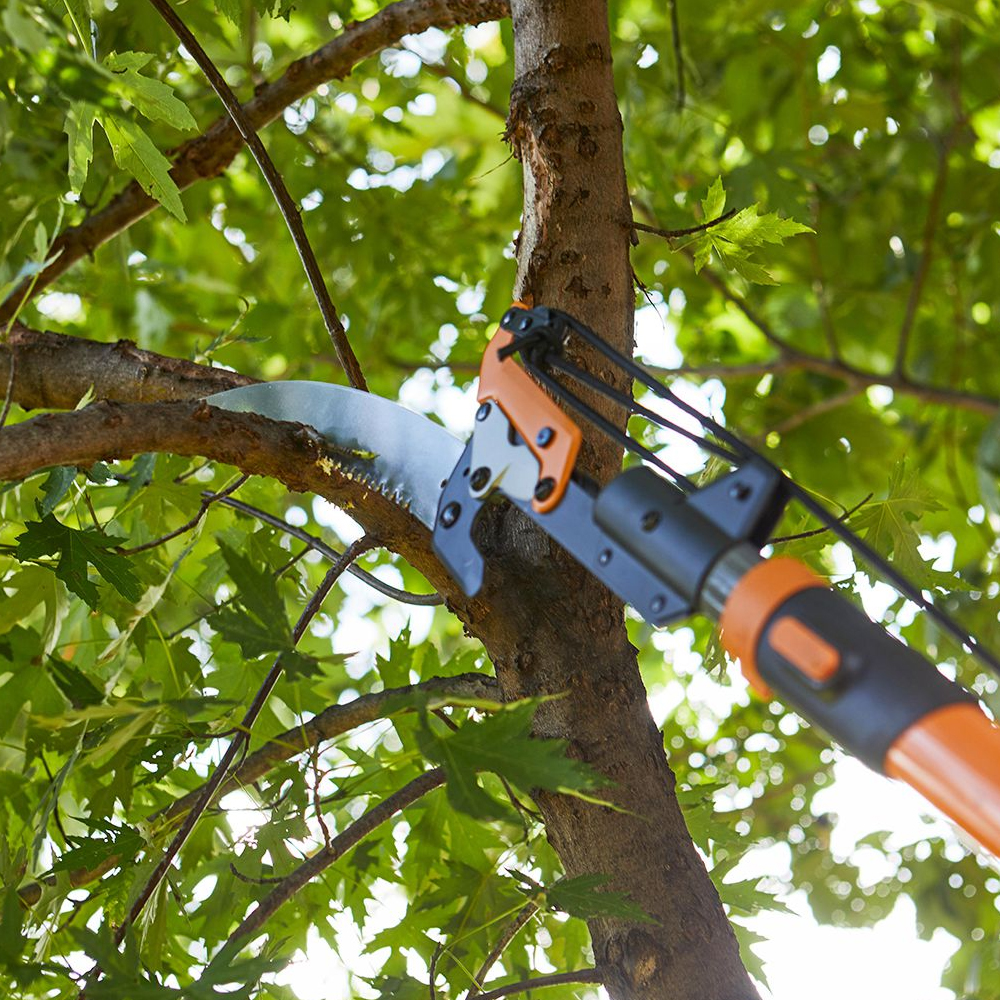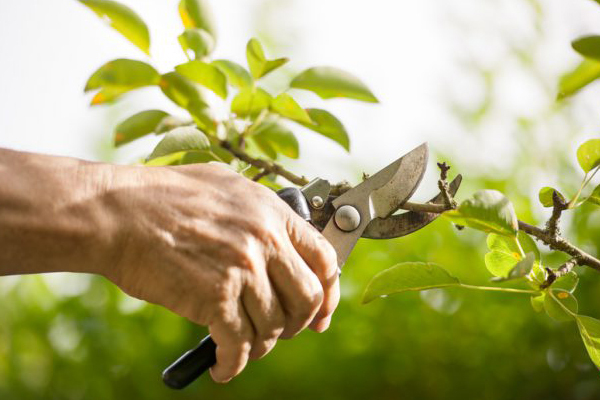If you have trees on your property, you know how important it is to keep them healthy and looking their best. One way to do this is through regular pruning. It’s an effective way to help remove dead or damaged branches and promote healthy growth. However, if you’re thinking about pruning your trees in the summer, you may want to think twice.
Here are five reasons why:

Reason #1: Pruning Can Stress Trees in Hot Weather
When a tree is pruned during the summer months, the exposed bark is vulnerable to the sun’s intense rays. That can cause the tree to develop sunscald.
A sunscald occurs when the bark on the tree heats up to the point that it dies or becomes damaged. This is because the bark acts as a protective barrier against the sun’s harmful rays. So when that same bark becomes damaged to the point it’s almost burnt from the sun, the tree is left vulnerable.
The damage caused by sunscald can be severe. If left untreated, it can weaken the tree and make it more susceptible to dehydration. When you see splitting, cracking, or peeling bark, your tree might have sunscald. In some cases, discolouration or scorching of the bark happens in intense heat.
Reason #2: Summer Pruning Can Attract Pests and Diseases
Pruning trees in the summer can also leave them with open wounds that attract pests and diseases. It’s when the majority of insects are active and trees are where they want to hang out. And freshly pruned trees are among their favourites.
This is because when a tree is pruned, it releases a scent that can attract insects towards it. Beetles and borers are the most common ones attracted and they can damage your tree. Also, pruning can create wounds on the tree that can serve as entry points for pathogens. This is where those same pathogens can cause diseases such as canker and blight.
Also, the warm and humid conditions of summer provide an ideal environment for microbial growth. Microbes like fungi can cause diseases that damage the tree in many ways. This combination of high humidity and warm temperatures makes the growth of diseases easier. It gives way to the growth of canker, blight, and powdery mildew much faster. These diseases can cause significant damage to your tree. And if not controlled, it may need extensive treatment to get back to normal.
Reason #3: Trees Heal More Slowly in Summer
During the summer months, trees tend to heal more slowly than they do during other times of the year. This is because warmer temperatures can cause the tree to lose more moisture through transpiration. And this can significantly slow down the healing process. So pruning during the summer can leave the tree more vulnerable to different kinds of damage.
To ensure that your trees heal properly, it’s best to prune them during the dormant season. Days during the late fall or winter fit in that season. During this time, the tree is not actively growing, which means it will have more energy to devote to healing.
Reason #4: Summer Pruning Can Result in Unsightly Trees
Pruning your trees in the summer can also cause them to produce unsightly growth. When a tree is pruned during the summer, it may respond by producing water sprouts or suckers. These are fast-growing shoots that grow straight up from the tree’s branches. And if you’re more into aesthetics, this can be a huge turnoff. Water sprouts and suckers can be unsightly and can also weaken the tree. They do just that by diverting energy away from the tree’s main branches.
To avoid unsightly growth, it’s best to prune your trees during the dormant season (again). This will give the tree time to heal properly. The chances of water sprouts and suckers developing will greatly reduce as a result.
Reason #5: Late Summer Pruning Can Encourage New Growth Before Winter
Finally, late summer pruning can encourage new growth on your trees just before winter. While this may sound like a good thing, it can actually be detrimental to the tree. This is especially true in areas with harsh winter weather. If you’re somewhere tropical, consider yourself lucky. New growth that develops just before winter is often more vulnerable to damage from frost and snow. And this can lead to further stress and damage to the tree.
And there’s more on top of the vulnerability to winter damage. New growth that develops just before winter may also not have enough time to harden off before the cold weather sets in. This can leave the new growth more susceptible to damage from wind and ice. So that new growth will just eventually die because it grew at the wrong time.
So to avoid that, do your regular pruning but not during the late summer months. Instead, wait until the dormant season before you do so. This way, you’ll encourage healthy growth in the spring or other seasons.

Tips on Summer Pruning
But if you do need to prune your trees during the summer months, it’s important to take caution. Summer pruning can be challenging, but with the right approach, you can ensure your trees remain healthy and strong. Here are some tips for minimizing the various risks of when pruning trees during the summer months:
1. Prune Early in the Day or Late in the Evening
To minimize the risk of dehydration, prune your trees early in the day or late in the evening when the temperatures are cooler. This will give the tree time to recover before the hot sun beats down on it. It’s also an effective way to reduce the risk of sunscald and dehydration.
2. Don’t Remove Too Much Foliage at Once
Another way to protect your tree is to avoid removing more than 25% of the tree’s foliage during a single pruning session. Removing too much foliage at once can put the tree under significant stress. It can also lead to further damage and make it more vulnerable to pests and diseases.
3. Sterilize Your Pruning Tools
Sterilizing your pruning tools is critical when pruning trees to avoid diseases. Open wounds created by pruning can attract insects and other pests that can cause disease and further damage. Use a 10% bleach solution to sterilize your pruning tools before and after each cut.
4. Use Proper Pruning Techniques
Using proper pruning techniques is essential when pruning trees during the summer months. Always make clean cuts to prevent tearing and damage to the tree. Cut branches at a 45-degree angle and avoid cutting too close to the trunk.
5. Consult with Gardening Services Adelaide
But if you’re unsure about how to prune your trees during the summer months, it’s always best to consult with professionals. We can provide advice on the best pruning techniques for your specific tree species. And if you’re busy, we can handle the heavy lifting for you.
We handle tree pruning, lawn mowing, gardening, rubbish removal, and gutter cleaning. So if you’re in a pinch taking care of your tree, get in touch with us. We’ll handle it with ease and get your pruning needs sorted.
Conclusion
All in all, while pruning is an essential part of tree maintenance, it’s best to avoid it altogether in summer. Summer pruning can stress trees, attract pests and diseases, and result in unsightly growth. Additionally, trees tend to heal more slowly during the heat of summer. And late summer pruning can encourage new growth just before winter. Something detrimental to the tree’s health.
To keep your trees healthy and looking their best, it’s best to prune them during the dormant season when they are not actively growing. This will give them the best chance to heal properly and grow strong and healthy in the coming year.
And remember, if you’re unsure about when to prune your trees, it’s always best to consult with a professional arborist. They’re the experts in this field and will be more than happy to help you out.

